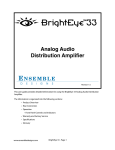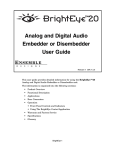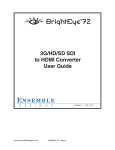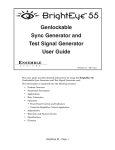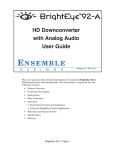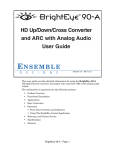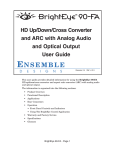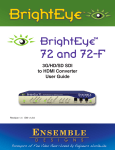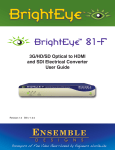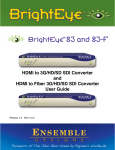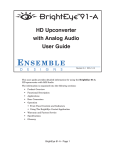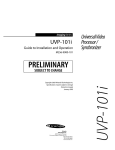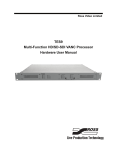Download BrightEye 71 and 71-F Manual 1.1
Transcript
HD/SD 8 Channel Analog Audio Embedder/Disembedder User Guide BrightEye 71 and 71-F TM BrightEye 71 and 71-F TM HD/SD 8 Channel Analog Audio Embedder/Disembedder User Guide Revision 1.1 SW v1.2.1 www.ensembledesigns.com BrightEye 71 and 71-F - Page 1 HD/SD 8 Channel Analog Audio Embedder/Disembedder User Guide BrightEye 71 and 71-F TM Contents PRODUCT OVERVIEW 3 FUNCTIONAL DESCRIPTION 3 Optical Output with the 71-F 3 APPLICATIONS5 Embedder (Mux) And Disembedder (Demux) 5 Embedder (Mux) 5 REAR CONNECTORS 6 Power Connection 6 USB Connector 6 HD/SD SDI Out 6 Analog Audio Connectors 6 HD/SD SDI In 6 OPERATION7 Front Panel Controls and Indicators 7 Status Indicators 7 ADJUSTMENTS 8 Adjusting Parameters from the Front Panel 8 USING THE BRIGHTEYE CONTROL APPLICATION 9 Config Menu 10 Audio Input Menu 11 Multiplexer Mode 11 Demultiplexer Mode 12 Mixer A Menu 13 Mixer B Menu 14 Audio Out Menu 15 www.ensembledesigns.com BrightEye 71 and 71-F - Page 2 HD/SD 8 Channel Analog Audio Embedder/Disembedder User Guide BrightEye 71 and 71-F TM SOFTWARE UPDATING 16 WARRANTY AND FACTORY SERVICE 16 Warranty16 Factory Service 16 SPECIFICATIONS17 BrightEye Power Supply Information 19 GLOSSARY20 www.ensembledesigns.com BrightEye 71 and 71-F - Page 3 HD/SD 8 Channel Analog Audio Embedder/Disembedder User Guide BrightEye 71 and 71-F TM PRODUCT OVERVIEW The BrightEye 71/71-F is a dual rate, eight channel audio embedder or disembedder for 1.5 Gb/s high definition video signals or for 270 Mb/s standard definition signals. The analog audio ports automatically configure for inputs or outputs when the module is configured for Mux or Demux. Selection of Mux or Demux mode, audio group selection, VU status, and gain can be monitored and adjusted from the front panel. More advanced functionality is available via the BrightEye Control application. The BrightEye 71/71-F includes an eight channel audio mixer with channel swap and shuffle capability that allows you to completely rearrange and remix audio channels. It provides precise control over audio level, up to 2 dB of gain to compensate for low level sources. All audio processing is performed at full 24 bit resolution by a digital signal processor (DSP). Delay is adjustable up to one second. The Data mode operation allows embedding or disembedding of Dolby E or AC3 signals. A glossary of commonly used video terms is provided at the end of this manual. FUNCTIONAL DESCRIPTION When configured as a multiplexer as shown in the functional block diagram below, the BrightEye 71/71-F has one serial digital video input and eight analog audio inputs. The audio streams are sample rate converted (allowing the use of asynchronous audio) then processed in the input selector and mixer/shuffler. The selected groups are then embedded into the video stream. The output of the module is a digital stream that contains the original video signal and four audio pairs. Optical Output with the 71-F The BrightEye 71-F offers one optical output and one SDI output. HD/SD SDI Out (follows input) HD/SD SDI In Embedder BE 71 HD/SD SDI Out (follows input) Balanced Analog Audio Inputs Ch 1/2 24 bit Audio A to D 2 Ch Optical Out 24 bit Audio A to D 2 Ch Ch 5/6 24 bit Audio A to D 2 Ch Ch 7/8 24 bit Audio A to D Ch 3/4 BE 71/71-F 8x8 Input Selector 8 Channel Mixer Shuffler and Delay 2 Ch BrightEye 71 / 71-F Multiplexer (Embedder) Mode Functional Block Diagram www.ensembledesigns.com BrightEye 71 and 71-F - Page 4 BE 71-F HD/SD 8 Channel Analog Audio Embedder/Disembedder User Guide BrightEye 71 and 71-F TM When configured as a demultiplexer as shown in the block diagram below, audio signals present in the incoming video signal are extracted, processed as desired, and delivered as analog audio. Note: BrightEye 71 has two electrical SDI outputs. BrightEye 71-F has one electrical SDI output and one optical output HD/SD SDI Out (follows input) HD/SD SDI In BE 71 2 Ch 2 Ch Balanced Analog Audio Outputs 24 bit Audio D to A Ch 1/2 24 bit Audio D to A Ch 3/4 HD/SD SDI Out (follows input) BE 71/71-F Optical Out 2 Ch 2 Ch 8x8 Input Selector Disembedder 8 Channel Mixer Shuffler BE 71-F 2 Ch 24 bit Audio D to A Ch 5/6 2 Ch 2 Ch 2 Ch 24 bit Audio D to A Ch 7/8 BrightEye 71 / 71-F Demultiplexer (Disembedder) Mode Functional Block Diagram www.ensembledesigns.com BrightEye 71 and 71-F - Page 5 HD/SD 8 Channel Analog Audio Embedder/Disembedder User Guide BrightEye 71 and 71-F TM APPLICATIONS The BrightEye 71/71-F is a highly versatile embedder/disembedder. Examples of possible BrightEye 71/71-F multiplex and demultiplex applications are given below. Embedder (Mux) And Disembedder (Demux) In this application, BrightEye 71/71-F can be used to multiplex video and audio together to feed a video server. The output from the video server can then be fed to another BrightEye 71/71-F where the audio can then be demultiplexed for another application. Mux Video Router HD or SD SDI Video Ch 1/2 Analog Audio Ch 3/4 Sources Ch 5/6 BE 71 Demux HD or SD SDI Video with Embedded Audio Video Server HD or SD SDI Video with Embedded Audio HD or SD SDI Video BE 71 Ch 1/2 Ch 3/4 Ch 5/6 Ch 7/8 Ch 7/8 BrightEye 71/71-F Multiplex and Demultiplex Application Embedder (Mux) In this application, serial digital audio from a router are combined into a single SDI output with embedded digital audio. HD or SD SDI Video from Camera Analog Ch 1/2 Audio Sources Ch 3/4 BE 71 HD or SD SDI Video with Embedded Audio BrightEye 71/71-F Multiplex Application www.ensembledesigns.com BrightEye 71 and 71-F - Page 6 Video Router Analog Audio Output HD/SD 8 Channel Analog Audio Embedder/Disembedder User Guide BrightEye 71 and 71-F TM REAR CONNECTORS All connections to the BrightEye 71/71-F are made on the rear of the unit. Refer to the illustration and detailed explanations below for a reference of the rear connectors. Power Connection Connect the modular power supply to the 12-volt DC power input connection on the far left of the unit. Use the locking ring to secure it. If you don’t have the power supply already, contact Ensemble Designs to purchase one. USB Connector Connect the USB port to a PC or Mac running BrightEye software for more comprehensive control, diagnostics, and upgrades to the unit. BrightEye PC/Mac Control application software is included on the CD that came with your unit, or the application can be downloaded here: http://www.ensembledesigns.com/support/brighteye-support/ HD/SD SDI Out This output is a digital stream that contains the original video signal. When the module is configured as a multiplexer, the four Phoenix connectors are configured as inputs. This external audio is multiplexed into the SDI output as desired. When the module is configured as a demultiplexer, this output contains the original video and the original embedded audio. The audio signals present in this incoming video signal are extracted and delivered as outputs on the analog audio Phoenix connectors. Analog Audio Connectors The four Phoenix connectors are either analog audio inputs or outputs depending on how the unit is configured (Mux or Demux). Each connector inputs or outputs 2 channels of audio (1 pair.) When the unit is configured as Mux, the four Phoenix connectors are inputs. When configured as Demux, the four Phoenix connectors are outputs. HD/SD SDI In This BNC input accepts an HD or SD SDI serial digital video signal with or without embedded audio. When the module is configured as a demultiplexer, embedded audio present on this input stream can be extracted, processed on the module, then output from the module on the audio outputs. When configured as a multiplexer, external analog audio can be inserted into the SDI input stream or replace existing embedded audio. www.ensembledesigns.com BrightEye 71 and 71-F - Page 7 HD/SD 8 Channel Analog Audio Embedder/Disembedder User Guide BrightEye 71 and 71-F TM OPERATION Control and operation of the BrightEye 71/71-F is performed from the front panel or with the BrightEye Control application. When controlling the module from the front panel, most, but not all of the control settings and parameter choices will be available. For more comprehensive control, use the BrightEye PC or Mac Control application. Front Panel Controls and Indicators The front panel shown in the figure below provides status indicators and control over module setup. Status Indicators The following status indicators are provided on the front panel: • In – Illuminates green when a valid input is present on the SDI In connector. • Mode – The currently selected mode (Mux or Demux) illuminates green. • Group – The audio group (1, 2, 3, or 4) currently targeted for embedding or disembedding (depending on module configuration) illuminates green when the selected group contains audio, and illuminates red when the selected group does not contain audio. • Gain – These controls allow for quick adjustment of Gain level for the four channel pairs. Gain adjustment is done in conjunction with the VU indicators. For independent channel adjustment, and other controls, use the BrightEye Control application. • VU – VU output level and the status of the Gain adjustment for each channel pair is indicated by the state of the VU and Gain indicators for each of the channel pairs. The VU indicator illuminates red when the audio level exceeds the headroom level set by the user (with the Peak Indicator control in the BrightEye Control application). Additionally, the VU indicator illuminates orange when the output is above 0 VU, illuminates green when the output is above -20 VU, and doesn’t illuminate when the output is below -20 VU. The Gain indicator illuminates red when the gain level has been adjusted to a value other than unity by the user. The 0 VU point corresponds in the digital domain to the digital reference level (-18 or -20 dBFS). • Mon Vol (Monitor Volume) – Illuminates green when monitor volume is set to unity, or red when set to other than unity. • Pwr (Power) – Illuminates green when the BrightEye unit has power and the internal voltage regulator is functioning correctly. www.ensembledesigns.com BrightEye 71 and 71-F - Page 8 HD/SD 8 Channel Analog Audio Embedder/Disembedder User Guide BrightEye 71 and 71-F TM ADJUSTMENTS Adjusting Parameters from the Front Panel From the front panel, use the Mode, Left Arrow, and Right Arrow buttons to select and adjust parameters. Pressing the Mode button cycles through the parameters that can be modified from the front panel. The LED of the currently selected parameter will blink. A quick press of the Mode button advances to the next editable parameter. A longer press of the Mode button will back up to the previous editable parameter. Pressing the Right Arrow or Left Arrow advances or backs up through the choices for the currently selected parameter, or increases (Right Arrow) or decreases (Left Arrow) the value of the selected parameter. The LED of an edited parameter will blink for 15 seconds, after which time its value is stored in memory. If power is interrupted before this 15 second timeout period has elapsed, the edited state will not be not saved. Pressing the Right Arrow and Left Arrow simultaneously restores the selected parameter to its default value. The controls and their indicators are described below: Mode – This control selects the Mux behavior with the following choices: • Mux – Embed audio into the SDI signal, replacing the existing embedded content or cascading (augmenting the existing embedded content). • Demux – Disembed audio that is in the SDI signal. Group Select – This control selects the audio group for embedding or disembedding with the following choices: • 1 – Audio Group 1, 2 – Audio Group 2, 3 – Audio Group, 4 – Audio Group 4 Ch 1/2, Ch 3/4, Ch 5/6, and Ch 7/8 Gain Adjustment Indicators – These controls allow for quick adjustment of Gain level for these two channel pairs. For independent channel adjustment, and other controls, use the BrightEye PC or BrightEye Mac application. Ch 1/2, Ch 3/4, Ch 5/6, and Ch 7/8 VU Indicators – These indicators provide information about the level of the analog outputs on these channels. More detailed indicators are available through the BrightEye Control application. www.ensembledesigns.com BrightEye 71 and 71-F - Page 9 HD/SD 8 Channel Analog Audio Embedder/Disembedder User Guide BrightEye 71 and 71-F TM USING THE BRIGHTEYE CONTROL APPLICATION The BrightEye PC and BrightEye Mac applications included on CD-ROM are designed to allow you to configure and control the BrightEye 71/71-F from a personal computer. Instructions for installing and using this software application are given in the PDF manual on the CD-ROM. BrightEye PC/Mac Control application software is included on CD that came with your unit, or the application can be downloaded here: http://www.ensembledesigns.com/support/brighteye-support/ If the BrightEye 71/71-F is connected to a computer running this software, the menus described in the following pages are available for controlling and monitoring the unit. www.ensembledesigns.com BrightEye 71 and 71-F - Page 10 HD/SD 8 Channel Analog Audio Embedder/Disembedder User Guide BrightEye 71 and 71-F TM Config Menu • Input Pres – indicates the presence of an HD or SD SDI input. One of the following values will be displayed: 720p/50, 720p/59.94, 720p/60, 1080i/50, 1080i/59.94, 1080i/60, 1080p/25, 1080p/23.98, 1080p/24, 1080p/25, 1080sF/25, 1080sF/23.98, 1080sF/24, SD 525, SD 625, No Input, or Unknown. • Audio Mode – select the mode of the module as Mux or Demux. • Mux Mode – select the type of multiplexing desired from Mux Replace or Mux Cascade. • Dig Ref Level – select the digital reference level. This pulldown lets you choose between: -20 dBFS or -18 dBFS. • Peak Indicator – select the amount of headroom to use in determining peak levels. This pulldown lets you chose between: Clipping, 2 dB Headroom, 4 dB Headroom, 6 dB Headroom, 8 dB Headroom, or 10 dB Headroom. • Anlg Ref Level – select the analog reference level. This pulldown lets you choose between -10 dBu or +4 dBu. • Audio Delay – allows you to set the amount of audio delay from 0 to 1000 mSec. Default is 0 mSec. • Strip Audio – when On all audio and EDH is stripped from the incoming stream. Off leaves audio and EDH as it comes in on the input signal. www.ensembledesigns.com BrightEye 71 and 71-F - Page 11 HD/SD 8 Channel Analog Audio Embedder/Disembedder User Guide BrightEye 71 and 71-F TM Audio Input Menu The appearance of the Input menu will depend on the mode of the module and the type of audio being used. Multiplexer Mode When the module is set for Mux, the Aud Input menu provides the controls shown below: • Group A Status – the status of the audio selected in Group A Select will be displayed as No Audio Present, Group 1 OK, Group 2 OK, Group 3 OK, or Group 4 OK. • Group B Status – the status of the audio selected in Group B Select will be displayed as No Audio Present, Group 1 OK, Group 2 OK, Group 3 OK, Group 4 OK or Off. • Group A Select – select the audio group to multiplex from Group 1, Group 2, Group 3, or Group 4. • Group B Select – select the audio group to multiplex from Group 1, Group 2, Group 3, Group 4, or Off. www.ensembledesigns.com BrightEye 71 and 71-F - Page 12 HD/SD 8 Channel Analog Audio Embedder/Disembedder User Guide BrightEye 71 and 71-F TM Demultiplexer Mode When the module is set for Demux, the Aud Input menu provides the controls shown below: • Group A Status – the status of the audio selected in Group A Select will be displayed as No Audio Present, Group 1 OK, Group 2 OK, Group 3 OK, or Group 4 OK. • Group B Status – the status of the audio selected in Group B Select will be displayed as No Audio Present, Group 1 OK, Group 2 OK, Group 3 OK, Group 4 OK or Off. • Group A Select – select the audio group to demultiplex from Group 1, Group 2, Group 3, or Group 4. • Group B Select – select the audio group to demultiplex from Group 1, Group 2, Group 3, Group 4, or Off. www.ensembledesigns.com BrightEye 71 and 71-F - Page 13 HD/SD 8 Channel Analog Audio Embedder/Disembedder User Guide BrightEye 71 and 71-F TM Mixer A Menu • Outputs 1-4 – provides peak/VU status, with the same methodology as the front panel VU indicators, but on a per-channel basis, rather than per- channel pair. Peak/VU indicators illuminate red when the audio level on that channel exceeds the headroom level set by the user (with the Peak Indicator control.) Additionally, the VU indicator illuminates orange when the output is above 0 VU, illuminates green when the output is above -20 VU, and doesn’t illuminate when the output is below -20 VU. • Inputs Ch 1-4 – these controls provide mixing and output level control for audio channels 1 to 4 of the selected audio group. The text field at the top of the control indicates the amount of gain applied to the channel in dB. The gain level can be adjusted by moving the vertical slider control, using the up down arrows, or entering a desired level directly in the field (from -70 dB to +12 dB.) On the right- hand side of the control are Out Bus Ch Assign buttons. These buttons control which analog output channel the audio channels are mapped to. It is possible to map an Input channel to anywhere from zero to eight output channels. The Tie function is used for stereo operation where gain of a pair of channels is usually desired to be the same. The Default button resets the gain to unity (0 dB). The Invert button allows inversion of a channel to permit phase correction. When an audio channel is a non-audio data signal, the controls on the Mixer A or Mixer B menu will be grayed out www.ensembledesigns.com BrightEye 71 and 71-F - Page 14 HD/SD 8 Channel Analog Audio Embedder/Disembedder User Guide BrightEye 71 and 71-F TM Mixer B Menu • Outputs 5-8 – provides peak/VU status, with the same methodology as the front panel VU indicators, but on a per-channel basis, rather than per-channel pair. Peak/VU indicators illuminate red when the audio level on that channel exceeds the headroom level set by the user (with the Peak Indicator control.) Additionally, the VU indicator illuminates orange when the output is above 0 VU, illuminates green when the output is above -20 VU, and doesn’t illuminate when the output is below -20 VU. • Inputs Ch 5-8 – these controls provide mixing and output level control for audio channels 5 to 8 of the selected audio group. The text field at the top of the control indicates the amount of gain applied to the channel in dB. The gain level can be adjusted by moving the vertical slider control, using the up down arrows, or entering a desired level directly in the field (from -70 dB to +12 dB.) On the right- hand side of the control are Out Bus Ch Assign buttons. These buttons control which analog output channel the audio channels are mapped to. It is possible to map an Input channel to anywhere from zero to eight output channels. The Tie function is used for stereo operation where gain of a pair of channels is usually desired to be the same. The Default button resets the gain to unity (0 dB). The Invert button allows inversion of a channel to permit phase correction. When an audio channel is a non-audio data signal, the controls on the Mixer A or Mixer B menu will be grayed out www.ensembledesigns.com BrightEye 71 and 71-F - Page 15 HD/SD 8 Channel Analog Audio Embedder/Disembedder User Guide BrightEye 71 and 71-F TM Audio Out Menu Mon Assign – choose the audio pair that is output on the Audio Monitor headphone jack. Choices are: Chan 1/2, Chan 3/4, Chan 5/6, Chan 7/8. Mon Volume – set the volume level sent to the headphone jack from 0 to 100%. Default is 100%. www.ensembledesigns.com BrightEye 71 and 71-F - Page 16 HD/SD 8 Channel Analog Audio Embedder/Disembedder User Guide BrightEye 71 and 71-F TM SOFTWARE UPDATING Software upgrades for BrightEyes are available at the following link: http://www.ensembledesigns.com/support/brighteye-support/ Use BrightEye Mac or PC software to install the software update into your BrightEye. WARRANTY AND FACTORY SERVICE Warranty This unit is covered by a five-year limited warranty. If you require service (under warranty or not), please contact Ensemble Designs and ask for customer service before you return the unit. This will allow the service technician an opportunity to provide any other suggestions for identifying the problem and to recommend possible solutions. Factory Service If you return equipment for repair, please get a Return Material Authorization Number (RMA) from the factory first. Ship the product and a written description of the problem to: Ensemble Designs, Inc. Attention: Customer Service RMA ##### 870 Gold Flat Rd. Nevada City, CA. 95959 USA (530) 478-1830 Fax: (530) 478-1832 [email protected] http://www.ensembledesigns.com Be sure to put your RMA number on the outside of the box. www.ensembledesigns.com BrightEye 71 and 71-F - Page 17 HD/SD 8 Channel Analog Audio Embedder/Disembedder User Guide BrightEye 71 and 71-F TM SPECIFICATIONS Serial Digital Input for BrightEye 71 Number One Type HD Serial Digital 1.485 Gb/s (SMPTE 274M, 292M or 296M) SD Serial Digital 270 Mb/s (SMPTE 259M-C) Impedance 75 Ω Return Loss >15 dB Max Cable Length 100 meters for HD 300 meters for SD (Belden 1694A) Automatic Input Cable Equalization HD Standards Supported 1080i (SMPTE 274M -4,5,6) 50, 59.94 or 60 Hz 720p (SMPTE 296M -1,2,3) 50, 59.94 or 60 Hz 1080p (SMPTE 274M -9,10,11) 23.98, 24, 25 Hz 1080sF (RP211 -14,15,16) 23.98, 24, 25 Hz Analog Audio Inputs Number Eight (selectable as inputs or outputs) Type Balanced Impedance >15K Ω Max Input Level 24 dBu CMRR >60 dB, 20 Hz to 10 KHz Quantization 24 bits, 128x oversampled Sample Rate 48 KHz Reference Level -10 dBu or +4 dBu Freq Response ±0.1 dB, 20 Hz to 20 KHz Crosstalk<106 dB Dynamic Range >106 dB Analog Audio Outputs Number Eight (selectable as inputs or outputs) Type Balanced, transformerless Impedance 30 Ω Max Output Level 24 dBu Resolution 24 bits, 128x oversampled Reference Level -10 dBu or +4 dBu Freq Response ±0.1 dB, 20 Hz to 20 KHz Crosstalk<106 dB Dynamic Range >106 dB www.ensembledesigns.com BrightEye 71 and 71-F - Page 18 HD/SD 8 Channel Analog Audio Embedder/Disembedder User Guide BrightEye 71 and 71-F TM Embedded Output (In SDI Outputs) Group Assign Cascade, or Replace any two of four groups Channels Eight Bit Depth 24 bit Serial Digital Output Number Two (BE71) One (BE71-F) Type Follows input Delay < 1 μSec. Audio is adjustable to 1 second Impedance 75 Ω Return Loss >15 dB Output DC None (AC coupled) Optical Output (only on the BrightEye 71-F) Number One ConnectorSP/UPC Type SD (SMPTE 297M, optical equivalent of 259M) HD (SMPTE 274M or 296M) Wavelength 1310 nm (non-CWDM) (1550 non-CWDM by special order) Power -7 dBm Max Cable Length 20 km (For greater distances, or higher power and larger loss budgets, please contact the factory) Fiber TypeSingle Mode Multi-mode compatible with 8 dB attenuation at transmit end NumberOne General Specifications Size 5.625” W x 0.8” H x 5.5” D (143 mm x 20 mm x 140 mm) including connectors Weight 1 lb 5 oz Power 12 volts, 8 watts (100-230 VAC modular power supply not included) Temperature Range 0 to 40° C ambient Relative Humidity 0 to 95%, non-condensing Altitude 0 to 10,000 feet www.ensembledesigns.com BrightEye 71 and 71-F - Page 19 HD/SD 8 Channel Analog Audio Embedder/Disembedder User Guide BrightEye 71 and 71-F TM BrightEye Power Supply Information Below is a list of power supplies and optional items that may have come with your BrightEye: BEPS BrightEye Individual Power Supply. BEPS6 Spider Power Supply. This powers 6 single high BrightEyes or 3 double high BrightEyes. BEPS6-RP Redundant Power Supply for Spider. BERKMT BrightEye Rack Mount. This holds 6 single high BrightEyes or 3 double high BrightEyes, or a combination. BEBP BrightEye Blank Panel. Single high, for empty slots in Rack Mount. BEAC Analog Audio Breakout Cable. www.ensembledesigns.com BrightEye 71 and 71-F - Page 20 HD/SD 8 Channel Analog Audio Embedder/Disembedder User Guide BrightEye 71 and 71-F TM GLOSSARY This is a brief glossary of commonly used terms associated with this product. AES/EBU The digital audio standard defined as a joint effort of the Audio Engineering Society and the European Broadcast Union. AES/EBU or AES3 describes a serial bit stream that carries two audio channels, thus an AES stream is a stereo pair. The AES/EBU standard covers a wide range of sample rates and quantizations (bit depths.) In television systems, these will generally be 48 kHz and either 20 or 24 bits. Aspect Ratio The ratio of the horizontal and vertical measurements of an image. 4:3 is the aspect ratio for standard definition video formats and television and 16:9 for high definition. Converting formats of unequal ratios is done by letter boxing (horizontal bars) or pillar boxing (vertical pillars) in order to keep the original format’s aspect ratio. Bandwidth Strictly speaking, this refers to the range of frequencies (i.e., the width of the band of frequency) used by a signal, or carried by a transmission channel. Generally, wider bandwidth will carry and reproduce a signal with greater fidelity and accuracy. Beta Sony Beta SP video tape machines use an analog component format that is similar to SMPTE, but differs in the amplitude of the color difference signals. It may also carry setup on the luminance channel. Blanking The Horizontal and Vertical blanking intervals of a television signal refer to the time periods between lines and between fields. No picture information is transmitted during these times, which are required in CRT displays to allow the electron beam to be repositioned for the start of the next line or field. They are also used to carry synchronizing pulses which are used in transmission and recovery of the image. Although some of these needs are disappearing, the intervals themselves are retained for compatibility purposes. They have turned out to be very useful for the transmission of additional content, such as teletext and embedded audio. CAV Component Analog Video. This is a convenient shorthand form, but it is subject to confusion. It is sometimes used to mean ONLY color difference component formats (SMPTE or Beta), and other times to include RGB format. In any case, a CAV signal will always require 3 connectors – either Y/R-Y/B-Y, or R/G/B. Checkfield A Checkfield signal is a special test signal that stresses particular aspects of serial digital transmission. The performance of the Phase Locked-Loops (PLLs) in an SDI receiver must be able to tolerate long www.ensembledesigns.com BrightEye 71 and 71-F - Page 21 HD/SD 8 Channel Analog Audio Embedder/Disembedder User Guide BrightEye 71 and 71-F TM runs of 0’s and 1’s. Under normal conditions, only very short runs of these are produced due to a scrambling algorithm that is used. The Checkfield, also referred to as the Pathological test signal, will “undo” the scrambling and cause extremely long runs to occur. This test signal is very useful for testing transmission paths. Chroma The color or chroma content of a signal, consisting of the hue and saturation of the image. See also Color Difference. Component In a component video system, the totality of the image is carried by three separate but related components. This method provides the best image fidelity with the fewest artifacts, but it requires three independent transmission paths (cables). The commonly used component formats are Luminance and Color Difference (Y/Pr/Pb), and RGB. It was far too unwieldy in the early days of color television to even consider component transmission. Composite Composite television dates back to the early days of color transmission. This scheme encodes the color difference information onto a color subcarrier. The instantaneous phase of the subcarrier is the color’s hue, and the amplitude is the color’s saturation or intensity. This subcarrier is then added onto the existing luminance video signal. This trick works because the subcarrier is set at a high enough frequency to leave spectrum for the luminance information. But it is not a seamless matter to pull the signal apart again at the destination in order to display it or process it. The resultant artifacts of dot crawl (also referred to as chroma crawl) are only the most obvious result. Composite television is the most commonly used format throughout the world, either as PAL or NTSC. It is also referred to as Encoded video. Color Difference Color Difference systems take advantage of the details of human vision. We have more acuity in our black and white vision than we do in color. This means that we need only the luminance information to be carried at full bandwidth—we can scrimp on the color channels. In order to do this, RGB information is converted to carry all of the luminance (Y is the black and white of the scene) in a single channel. The other two channels are used to carry the “color difference.” Noted as B-Y and R-Y, these two signals describe how a particular pixel “differs” from being purely black and white. These channels typically have only half the bandwidth of the luminance. Decibel (dB) The decibel is a unit of measure used to express the ratio in the amplitude or power of two signals. A difference of 20 dB corresponds to a 10:1 ratio between two signals, 6 dB is approximately a 2:1 ratio. Decibels add while the ratios multiply, so 26 dB is a 20:1 ratio, and 14 dB is a 5:1 ratio. There are several special cases of the dB scale where the reference is implied. Thus, dBm refers to power relative to 1 milliwatt, and dBu refers to voltage relative to .775V RMS. The original unit of measure was the Bel (10 times bigger), named after Alexander Graham Bell. www.ensembledesigns.com BrightEye 71 and 71-F - Page 22 HD/SD 8 Channel Analog Audio Embedder/Disembedder User Guide BrightEye 71 and 71-F TM dBFS In Digital Audio systems, the largest numerical value that can be represented is referred to as Full Scale. No values or audio levels greater than FS can be reproduced because they would be clipped. The nominal operating point (roughly corresponding to 0 VU) must be set below FS in order to have headroom for audio peaks. This operating point is described relative to FS, so a digital reference level of -20 dBFS has 20 dB of headroom before hitting the FS clipping point. DVI Digital Visual Interface. DVI-I (integrated) provides both digital and analog connectivity. The larger group of pins on the connector are digital while the four pins on the right are analog. EDH Error Detection and Handling is a method to verify proper reception of an SDI or HD SDI signal at the destination. The originating device inserts a data packet in the vertical interval of the SDI signal and every line of the HD signal which contains a checksum of the entire video frame. This checksum is formed by adding up the numerical values of all of the samples in the frame, using a complex formula. At the destination this same formula is applied to the incoming video and the resulting value is compared to the one included in the transmission. If they match, then the content has all arrived with no errors. If they don’t, then an error has occurred. Embedded Audio Digital Audio can be carried along in the same bit stream as an SDI or HD SDI signal by taking advantage of the gaps in the transmission which correspond to the horizontal and vertical intervals of the television waveform. This technique can be very cost effective in transmission and routing, but can also add complexity to signal handling issues because the audio content can no longer be treated independently of the video. Frame Sync A Frame Synchronizer is used to synchronize the timing of a video signal to coincide with a timing reference (usually a color black signal that is distributed throughout a facility). The synchronizer accomplishes this by writing the incoming video into a frame buffer memory under the timing direction of the sync information contained in that video. Simultaneously the memory is being read back by a timing system that is genlocked to a house reference. As a result, the timing or alignment of the video frame can be adjusted so that the scan of the upper left corner of the image is happening simultaneously on all sources. This is a requirement for both analog and digital systems in order to perform video effects or glitch-free switches in a router. Frame synchronization can only be performed within a single television line standard. A synchronizer will not convert an NTSC signal to a PAL signal; it takes a standards converter to do that. Frequency Response A measurement of the accuracy of a system to carry or reproduce a range of signal frequencies. Similar to Bandwidth. www.ensembledesigns.com BrightEye 71 and 71-F - Page 23 HD/SD 8 Channel Analog Audio Embedder/Disembedder User Guide BrightEye 71 and 71-F TM HDMI The High Definition Multimedia Interface comes to us from the consumer marketplace where it is becoming the de facto standard for the digital interconnect of display devices to audio and video sources. It is an uncompressed, all-digital interface that transmits digital video and eight channels of digital audio. HDMI is a bit-serial interface that carries the video content in digital component form over multiple twisted-pairs. HDMI is closely related to the DVI interface for desktop computers and their displays. IEC The International Electrotechnical Commission provides a wide range of worldwide standards. They have provided standardization of the AC power connection to products by means of an IEC line cord. The connection point uses three flat contact blades in a triangular arrangement, set in a rectangular connector. The IEC specification does not dictate line voltage or frequency. Therefore, the user must take care to verify that a device either has a universal input (capable of 90 to 230 volts, either 50 or 60 Hz), or that a line voltage switch, if present, is set correctly. Interlace Human vision can be fooled to see motion by presenting a series of images, each with a small change relative to the previous image. In order to eliminate the flicker, our eyes need to see more than 30 images per second. This is accomplished in television systems by dividing the lines that make up each video frame (which run at 25 or 30 frames per second) into two fields. All of the odd-numbered lines are transmitted in the first field, the even-numbered lines in the second field. In this way, the repetition rate is 50 or 60 Hz, without using more bandwidth. This trick has worked well for years, but it introduces other temporal artifacts. Motion pictures use a slightly different technique to raise the repetition rate from the original 24 frames that occur each second—they just project each one twice. IRE Video level is measured on the IRE scale, where 0 IRE is black, and 100 IRE is full white. The actual voltages that these levels correspond to can vary between formats. ITU-R 601 This is the principal standard for standard definition component digital video. It defines the luminance and color difference coding system that is also referred to as 4:2:2. The standard applies to both PAL and NTSC derived signals. They both will result in an image that contains 720 pixels horizontally, with 486 vertical pixels in NTSC, and 576 vertically in PAL. Both systems use a sample clock rate of 27 MHz, and are serialized at 270 Mb/s. Jitter Serial digital signals (either video or audio) are subject to the effects of jitter. This refers to the instantaneous error that can occur from one bit to the next in the exact position of each digital transition. Although the signal may be at the correct frequency on average, in the interim it varies. Some bits come slightly early, other come slightly late. The measurement of this jitter is given either as the amount of time uncertainty or as the fraction of a bit width. For 270 Mb/s video, the allowable jitter is 740 picoseconds, or 0.2 UI (Unit Interval – one bit width). www.ensembledesigns.com BrightEye 71 and 71-F - Page 24 HD/SD 8 Channel Analog Audio Embedder/Disembedder User Guide BrightEye 71 and 71-F TM Luminance The “black & white” content of the image. Human vision has more acuity in luminance, so television systems generally devote more bandwidth to the luminance content. In component systems, the luminance is referred to as Y. Multi-mode Multi-mode optical fibers have a larger diameter core (either 50 or 62.5 microns) and a correspondingly larger aperture. It is much easier to couple light energy into a multi-mode fiber, but internal reflections will cause multiple “modes” of the signal to propagate down the fiber. This will degrade the ability of the fiber to be used over long distances. See also Single mode. NTSC The color television encoding system used in North America was originally defined by the National Television Standards Committee. This American standard has also been adopted by Canada, Mexico, Japan, Korea, and Taiwan. (This standard is referred to disparagingly as Never Twice Same Color.) Optical An optical interface between two devices carries data by modulating a light source. This light source is typically a laser or laser diode (similar to an LED) which is turned on and off at the bit rate of the data stream. The light is carried from one device to another through a glass fiber. The fiber’s core acts as a waveguide or lightpipe to carry the light energy from one end to another. Optical transmission has two very significant advantages over metallic copper cables. Firstly, it does not require that the two endpoint devices have any electrical connection to each other. This can be very advantageous in large facilities where problems with ground loops appear. Secondly, and most importantly, an optical interface can carry a signal for many kilometers or miles without any degradation or loss in the recovered signal. Copper is barely useful at distances of just 1000 feet. Oversampling A technique to perform digital sampling at a multiple of the required sample rate. This has the advantage of raising the Nyquist Rate (the maximum frequency which can be reproduced by a given sample rate) much higher than the desired passband. This allows more easily realized anti-aliasing filters. PAL During the early days of color television in North America, European broadcasters developed a competing system called Phase Alternation by Line. This slightly more complex system is better able to withstand the differential gain and phase errors that appear in amplifiers and transmission systems. (Engineers at the BBC claim that it stands for Perfection At Last.) Progressive An image scanning technique which progresses through all of the lines in a frame in a single pass. Computer monitors all use progressive displays. This contrasts to the interlace technique common to television systems. www.ensembledesigns.com BrightEye 71 and 71-F - Page 25 HD/SD 8 Channel Analog Audio Embedder/Disembedder User Guide BrightEye 71 and 71-F TM Return Loss An idealized input or output circuit will exactly match its desired impedance (generally 75 ohms) as a purely resistive element, with no reactive (capacitive or inductive) elements. In the real world we can only approach the ideal. So our real inputs and outputs will have some capacitance and inductance. This will create impedance matching errors, especially at higher frequencies. The Return Loss of an input or output measures how much energy is returned (reflected back due to the impedance mismatch). For digital circuits, a return loss of 15 dB is typical. This means that the energy returned is 15 dB less than the original signal. In analog circuits, a 40 dB figure is expected. RGB RGB systems carry the totality of the picture information as independent Red, Green, and Blue signals. Television is an additive color system, where all three components add to produce white. Because the luminance (or detail) information is carried partially in each of the RGB channels, all three must be carried at full bandwidth in order to faithfully reproduce an image. ScH Phase Used in composite systems, ScH Phase measures the relative phase between the leading edge of sync on line 1 of field 1 and a continuous subcarrier sine wave. Due to the arithmetic details of both PAL and NTSC, this relationship is not the same at the beginning of each frame. In PAL, the pattern repeats every 4 frames (8 fields), which is also known as the Bruch Blanking sequence. In NTSC, the repeat is every 2 frames (4 fields). This creates enormous headaches in editing systems and the system timing of analog composite facilities. SDI Serial Digital Interface. This term refers to inputs and outputs of devices that support serial digital component video. This could refer to standard definition at 270 Mb/s, HD SDI or High Definition Serial Digital video at 1.485 Gb/s, or to the newer 3G standard of High Definition video at 2.97 Gb/s. SMPTE The Society of Motion Picture and Television Engineers is a professional organization which has done tremendous work in setting standards for both the film and television industries. The term “SMPTE’” is also shorthand for one particular component video format—luminance and color difference. Single mode A Single mode (or monomode) optical fiber carries an optical signal on a very small diameter (9 micron) core surrounded with cladding. The small diameter means that no internally reflected lightwaves will be propagated. Thus only the original “mode” of the signal passes down the fiber. A single mode fiber used in an optical SDI system can carry a signal for up to 20 kilometers. Single mode fibers require particular care in their installation due to the extremely small optical aperture that they present at splice and connection points. See also Multi-mode. www.ensembledesigns.com BrightEye 71 and 71-F - Page 26 HD/SD 8 Channel Analog Audio Embedder/Disembedder User Guide BrightEye 71 and 71-F TM TBC A Time Base Corrector is a system to reduce the Time Base Error in a signal to acceptable levels. It accomplishes this by using a FIFO (First In, First Out) memory. The incoming video is written into the memory using its own jittery timing. This operation is closely associated with the actual digitization of the analog signal because the varying position of the sync timing must be mimicked by the sampling function of the analog-to-digital converter. A second timing system, genlocked to a stable reference, is used to read the video back out of the memory. The memory acts as a dynamically adjusting delay to smooth out the imperfections in the original signal’s timing. Very often a TBC will also function as a Frame Synchronizer. See also Frame Sync. Time Base Error Time base error is present when there is excessive jitter or uncertainty in the line-to-line output timing of a video signal. This is commonly associated with playback from video tape recorders and is particularly severe with consumer type heterodyne systems like VHS. Time base error will render a signal unusable for broadcast or editing purposes. Tri Level Sync An analog sync reference signal that is used in High Definition systems. Tri Level Sync is constructed with three signal levels: the sync pulses extend above and below a mid-level average voltage (the blanking level). Unlike conventional analog sync which is bi-level, the proper 50% pickoff point is already identified in Tri Level Sync. This contributes to lower jitter in digital systems. VGA Video Graphics Array. Traditional 15-pin, analog interface between a PC and monitor. YUV Strictly speaking, YUV does not apply to component video. The letters refer to the Luminance (Y), and the U and V encoding axes used in the PAL composite system. Since the U axis is very close to the B-Y axis, and the V axis is very close to the R-Y axis, YUV is often used as a sort of shorthand for the more long-winded “Y/R-Y/B-Y.” Y/Cr/Cb In digital component video, the luminance component is Y, and the two color difference signals are Cr (R-Y) and Cb (B-Y). Y/Pr/Pb In analog component video, the image is carried in three components. The luminance is Y, the R-Y color difference signal is Pr, and the B-Y color difference signal is Pb. www.ensembledesigns.com BrightEye 71 and 71-F - Page 27



























